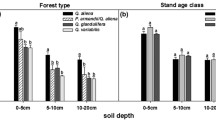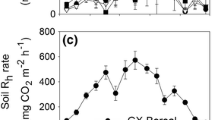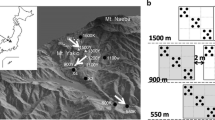Abstract
Mediterranean forests own distinct characteristics resulting from climate, soil, and vegetation that affect soil microbial communities’ assembly and their associated functions. We initiated a multi-scalar analysis of environmental drivers of soil functioning to (1) identify pertinent factorial scales and (2) determine the relative importance of soil, vegetation, and geoclimate influences in shaping soil microbial functions across the French Mediterranean forests. Soil samples (0–15 cm) were collected from 60 forest sites and soil physicochemical and microbiological properties were assessed across different factorial scales i.e., bioclimates, slope exposures, and forest stands. Patterns in microbial catabolic potential (i.e., extracellular enzymes and microbial respiration) and carbon (C) source utilization (i.e., catabolic-level physiological profiling) were partitioned between vegetation cover, soil characteristics, and geoclimate components. Our results reveal that the catabolic potential of soil microbes was strongly influenced by the forest stands and mainly relied on ammonium and nitrate contents. In contrast, variation in C source utilization was mainly explained by vegetation cover. Soil metabolic capacities of microorganisms and resulting C dynamics were largely constrained by climate parameters, which suggests potentially important consequences for soil C storage. Our study revealed diverse structuration patterns between the catabolic potential and the carbon source utilization of soil microbial communities, and gives insights into the underlying mechanisms of soil microbial functioning in Mediterranean forests.





Similar content being viewed by others
References
Bradford MA, Wieder WR, Bonan GB, Fierer N, Raymond PA, Crowther TW (2016) Managing uncertainty in soil carbon feedbacks to climate change. Nat Clim Chang 6:751–758
Lal R (2005) Forest soils and carbon sequestration. For Soils Res Theory Real Its Role Technol Sel Ed Pap 10th North Am For Soils Conf Held Saulte Ste Marie Ont Can 20-24 July 2003 220:242–258. https://doi.org/10.1016/j.foreco.2005.08.015
Tian H, Lu C, Yang J, Banger K, Huntzinger DN, Schwalm CR, Michalak AM, Cook R, Ciais P, Hayes D, Huang M, Ito A, Jain AK, Lei H, Mao J, Pan S, Post WM, Peng S, Poulter B, Ren W, Ricciuto D, Schaefer K, Shi X, Tao B, Wang W, Wei Y, Yang Q, Zhang B, Zeng N (2015) Global patterns and controls of soil organic carbon dynamics as simulated by multiple terrestrial biosphere models: current status and future directions. Glob Biogeochem Cycles 29:775–792. https://doi.org/10.1002/2014GB005021
Pan Y, Birdsey RA, Fang J, Houghton R, Kauppi PE, Kurz WA, Phillips OL, Shvidenko A, Lewis SL, Canadell JG, Ciais P, Jackson RB, Pacala SW, McGuire AD, Piao S, Rautiainen A, Sitch S, Hayes D (2011) A large and persistent carbon sink in the world’s forests. Science 333:988–993. https://doi.org/10.1126/science.1201609
Romaní AM, Fischer H, Mille-Lindblom C, Tranvik LJ (2006) Interactions of bacteria and fungi on decomposing litter: differential extracellular enzyme activities. Ecology 87:2559–2569
Bardgett RD, Freeman C, Ostle NJ (2008) Microbial contributions to climate change through carbon cycle feedbacks. ISME J 2:805–814
Davidson EA, Janssens IA (2006) Temperature sensitivity of soil carbon decomposition and feedbacks to climate change. Nature 440:165–173
Rousk J, Baaath E, Brookes PC et al (2010) Soil bacterial and fungal communities across a pH gradient in an arable soil. ISME J 4:1340–1351
Rousk J, Brookes PC, Baath E (2009) Contrasting soil pH effects on fungal and bacterial growth suggest functional redundancy in carbon mineralization. Appl Environ Microbiol 75:1589–1596. https://doi.org/10.1128/AEM.02775-08
Fierer N, Lauber CL, Ramirez KS, Zaneveld J, Bradford MA, Knight R (2012) Comparative metagenomic, phylogenetic and physiological analyses of soil microbial communities across nitrogen gradients. ISME J 6:1007–1017. https://doi.org/10.1038/ismej.2011.159
Bonanomi G, Capodilupo M, Incerti G, Mazzoleni S (2014) Nitrogen transfer in litter mixture enhances decomposition rate, temperature sensitivity, and C quality changes. Plant Soil 381:307–321. https://doi.org/10.1007/s11104-014-2119-4
Plassart P, Prévost-Bouré NC, Uroz S, Dequiedt S, Stone D, Creamer R, Griffiths RI, Bailey MJ, Ranjard L, Lemanceau P (2019) Soil parameters, land use, and geographical distance drive soil bacterial communities along a European transect. Sci Rep 9:1–17. https://doi.org/10.1038/s41598-018-36867-2
Castaño C, Lindahl BD, Alday JG, Hagenbo A, Martínez de Aragón J, Parladé J, Pera J, Bonet JA (2018) Soil microclimate changes affect soil fungal communities in a Mediterranean pine forest. New Phytol 220:1211–1221. https://doi.org/10.1111/nph.15205
Brunel C, Gros R, Lerch TZ, Da Silva AMF (2020) Changes in soil organic matter and microbial communities after fine and coarse residues inputs from Mediterranean tree species. Appl Soil Ecol 149:103516
Boukhdoud N, Silva AMFD, Darwish T, Gros R (2017) Olive mill waste and glyphosate-based herbicide addition to olive grove soils: effects on microbial activities and their responses to drying–rewetting cycles. Soil Use Manag 33:499–510. https://doi.org/10.1111/sum.12367
Hijmans RJ, Cameron SE, Parra JL, Jones PG, Jarvis A (2005) Very high resolution interpolated climate surfaces for global land areas. Int J Climatol 25:1965–1978. https://doi.org/10.1002/joc.1276
Medail F, Quezel P (2003) Que faut-il entendre par “forêts méditerranéennes”? XXIV:
Chaney RC, Slonim SM, Slonim SS (1982) Determination of calcium carbonate content in soils. In: Geotechnical properties, behavior, and performance of calcareous soils. ASTM International, 3-15, https://doi.org/10.1520/STP28907S
Aubert G (1978) Méthodes d’analyses des sols. Centre national de documentation pédagogique, Centre régional de documentation pédagogique de Marseille
Massiot D, Fayon F, Capron M, King I, le Calvé S, Alonso B, Durand JO, Bujoli B, Gan Z, Hoatson G (2002) Modelling one-and two-dimensional solid-state NMR spectra. Magn Reson Chem 40:70–76
Baldock J, Preston CM (1995) Chemistry of carbon decomposition processes in forests as revealed by solid-state 13C NMR. 89–117, https://doi.org/10.2136/1995.carbonforms.c6
Beare MH, Neely CL, Coleman DC, Hargrove WL (1990) A substrate-induced respiration (SIR) method for measurement of fungal and bacterial biomass on plant residues. Soil Biol Biochem 22:585–594. https://doi.org/10.1016/0038-0717(90)90002-H
Anderson T-H (2003) Microbial eco-physiological indicators to asses soil quality. Agric Ecosyst Environ 98:285–293. https://doi.org/10.1016/S0167-8809(03)00088-4
Saiya-Cork K, Sinsabaugh R, Zak D (2002) The effects of long term nitrogen deposition on extracellular enzyme activity in an Acer saccharum forest soil. Soil Biol Biochem 34:1309–1315
Goujard L, Villeneuve P, Barea B, Lecomte J, Pina M, Claude S, le Petit J, Ferré E (2009) A spectrophotometric transesterification-based assay for lipases in organic solvent. Anal Biochem 385:161–167
Ladd J, Butler J (1972) Short-term assays of soil proteolytic enzyme activities using proteins and dipeptide derivatives as substrates. Soil Biol Biochem 4:19–30
Farnet Da Silva AM, Qasemian L, Guiral D, Ferré E (2010) A modified method based on arsenomolybdate complex to quantify cellulase activities: application to litters. Pedobiologia 53:159–160. https://doi.org/10.1016/j.pedobi.2009.09.001
Mulvaney DL, America SSS of, Agronomy AS of (1996) Methods of soil analysis part 3: chemical methods. Amer Society of Agronomy, Madison
Braun-Blanquet J (1932) Plant sociology. The study of plant communities. First ed. Plant Sociol Study Plant Communities First Ed
Dixon P (2003) VEGAN, a package of R functions for community ecology. J Veg Sci 14:927–930. https://doi.org/10.1111/j.1654-1103.2003.tb02228.x
Peterson RA (2018) bestNormalize: normalizing transformation functions, R package version 1.2. 0
Quinn GP, Keough MJ (2002) Experimental design and data analysis for biologists. Cambridge University Press, Cambridge
Borcard D, Gillet F, Legendre P (2018) Unconstrained Ordination. In: Borcard D, Gillet F, Legendre P (eds) Numerical ecology with R. Springer International Publishing, Cham, pp 151–201
James G, Witten D, Hastie T, Tibshirani R (2013) An introduction to statistical learning. Springer, Berlin
Zuur AF, Ieno EN, Elphick CS (2010) A protocol for data exploration to avoid common statistical problems. Methods Ecol Evol 1:3–14
Benjamini Y, Hochberg Y (1995) Controlling the false discovery rate: a practical and powerful approach to multiple testing. J R Stat Soc Ser B Methodol 57:289–300
Lladó S, Baldrian P (2017) Community-level physiological profiling analyses show potential to identify the copiotrophic bacteria present in soil environments. PLoS One 12:e0171638. https://doi.org/10.1371/journal.pone.0171638
Waring BG, Averill C, Hawkes CV (2013) Differences in fungal and bacterial physiology alter soil carbon and nitrogen cycling: insights from meta-analysis and theoretical models. Ecol Lett 16:887–894. https://doi.org/10.1111/ele.12125
Six J, Frey SD, Thiet RK, Batten KM (2006) Bacterial and fungal contributions to carbon sequestration in agroecosystems. Soil Sci Soc Am J 70:555–569. https://doi.org/10.2136/sssaj2004.0347
McGuire KL, Treseder KK (2010) Microbial communities and their relevance for ecosystem models: decomposition as a case study. Soil Biol Biochem 42:529–535. https://doi.org/10.1016/j.soilbio.2009.11.016
Bardgett RD, Shine A (1999) Linkages between plant litter diversity, soil microbial biomass and ecosystem function in temperate grasslands. Soil Biol Biochem 31:317–321
Eisenhauer N, Beßler H, Engels C, Gleixner G, Habekost M, Milcu A, Partsch S, Sabais ACW, Scherber C, Steinbeiss S, Weigelt A, Weisser WW, Scheu S (2010) Plant diversity effects on soil microorganisms support the singular hypothesis. Ecology 91:485–496. https://doi.org/10.1890/08-2338.1
Scheibe A, Steffens C, Seven J, Jacob A, Hertel D, Leuschner C, Gleixner G (2015) Effects of tree identity dominate over tree diversity on the soil microbial community structure. Soil Biol Biochem 81:219–227. https://doi.org/10.1016/j.soilbio.2014.11.020
Thoms C, Gattinger A, Jacob M, Thomas FM, Gleixner G (2010) Direct and indirect effects of tree diversity drive soil microbial diversity in temperate deciduous forest. Soil Biol Biochem 42:1558–1565. https://doi.org/10.1016/j.soilbio.2010.05.030
Khlifa R, Paquette A, Messier C, Reich PB, Munson AD (2017) Do temperate tree species diversity and identity influence soil microbial community function and composition? Ecol Evol 7:7965–7974. https://doi.org/10.1002/ece3.3313
Chavez-Vergara B, Merino A, Vázquez-Marrufo G, García-Oliva F (2014) Organic matter dynamics and microbial activity during decomposition of forest floor under two native neotropical oak species in a temperate deciduous forest in Mexico. Geoderma 235–236:133–145. https://doi.org/10.1016/j.geoderma.2014.07.005
Pérez-Izquierdo L, Saint-André L, Santenoise P, Buée M, Rincón A (2018) Tree genotype and seasonal effects on soil properties and biogeochemical functioning in Mediterranean pine forests. Eur J Soil Sci 69:1087–1097. https://doi.org/10.1111/ejss.12712
Fierer N, Bradford MA, Jackson RB (2007) Toward an ecological classification of soil bacteria. Ecology 88:1354–1364
Lauber CL, Hamady M, Knight R, Fierer N (2009) Pyrosequencing-based assessment of soil pH as a predictor of soil bacterial community structure at the continental scale. Appl Environ Microbiol 75:5111–5120
Rutgers M, Wouterse M, Drost SM, Breure AM, Mulder C, Stone D, Creamer RE, Winding A, Bloem J (2016) Monitoring soil bacteria with community-level physiological profiles using BiologTM ECO-plates in the Netherlands and Europe. Appl Soil Ecol 97:23–35. https://doi.org/10.1016/j.apsoil.2015.06.007
Zechmeister-Boltenstern S, Keiblinger KM, Mooshammer M, Peñuelas J, Richter A, Sardans J, Wanek W (2015) The application of ecological stoichiometry to plant-microbial-soil organic matter transformations. Ecol Monogr 85:133–155. https://doi.org/10.1890/14-0777.1
Parton W, Silver WL, Burke IC, Grassens L, Harmon ME, Currie WS, King JY, Adair EC, Brandt LA, Hart SC, Fasth B (2007) Global-scale similarities in nitrogen release patterns during long-term decomposition. Science 315:361–364. https://doi.org/10.1126/science.1134853
Brunel C, Gros R, Ziarelli F, Da Silva AMF (2017) Additive or non-additive effect of mixing oak in pine stands on soil properties depends on the tree species in Mediterranean forests. Sci Total Environ 590:676–685
Pearson RG, Dawson TP (2003) Predicting the impacts of climate change on the distribution of species: are bioclimate envelope models useful? Glob Ecol Biogeogr 12:361–371. https://doi.org/10.1046/j.1466-822X.2003.00042.x
Pons A, Quézel P (1998) À propos de la mise en place du climat méditerranéen. C R Acad Sci Ser IIA Earth Planet Sci 327:755–760. https://doi.org/10.1016/S1251-8050(99)80047-0
Sardans J, Peñuelas J (2013) Plant-soil interactions in Mediterranean forest and shrublands: impacts of climatic change. Plant Soil 365:1–33. https://doi.org/10.1007/s11104-013-1591-6
Bhunia RK, Showman LJ, Jose A, Nikolau BJ (2018) Combined use of cutinase and high-resolution mass-spectrometry to query the molecular architecture of cutin. Plant Methods 14:117. https://doi.org/10.1186/s13007-018-0384-6
Lal R (2018) Digging deeper: a holistic perspective of factors affecting soil organic carbon sequestration in agroecosystems. Glob Chang Biol 24:3285–3301. https://doi.org/10.1111/gcb.14054
Rowley MC, Grand S, Verrecchia ÉP (2018) Calcium-mediated stabilisation of soil organic carbon. Biogeochemistry 137:27–49. https://doi.org/10.1007/s10533-017-0410-1
Yuste JC, Fernandez-Gonzalez AJ, Fernandez-Lopez M et al (2014) Strong functional stability of soil microbial communities under semiarid Mediterranean conditions and subjected to long-term shifts in baseline precipitation. Soil Biol Biochem 69:223–233
Paul EA (2014) Soil microbiology, ecology and biochemistry. Academic press, Cambridge
Tardy V, Mathieu O, Lévêque J, Terrat S, Chabbi A, Lemanceau P, Ranjard L, Maron PA (2014) Stability of soil microbial structure and activity depends on microbial diversity. Environ Microbiol Rep 6:173–183
Chomel M, Guittonny-Larchevêque M, Fernandez C, Gallet C, DesRochers A, Paré D, Jackson BG, Baldy V (2016) Plant secondary metabolites: a key driver of litter decomposition and soil nutrient cycling. J Ecol 104:1527–1541
Mutabaruka R, Hairiah K, Cadisch G (2007) Microbial degradation of hydrolysable and condensed tannin polyphenol–protein complexes in soils from different land-use histories. Soil Biol Biochem 39:1479–1492
Rovira P, Vallejo VR (2002) Labile and recalcitrant pools of carbon and nitrogen in organic matter decomposing at different depths in soil: an acid hydrolysis approach. Geoderma 107:109–141. https://doi.org/10.1016/S0016-7061(01)00143-4
Pook EW et al (1966) The influence of aspect on the composition and structure of dry sclerophyll forest on Black Mountain, Canberra. ACT. Aust J Bot 14:223–242
Cantlon JE (1953) Vegetation and microclimates on north and south slopes of Cushetunk Mountain, New Jersey. Ecol Monogr 23:241–270
Martínez-Murillo JF, Gabarrón-Galeote MA, Ruiz-Sinoga JD (2013) Soil water repellency in Mediterranean rangelands under contrasted climatic, slope and patch conditions in southern Spain. Catena 110:196–206
Nadal-Romero E, Petrlic K, Verachtert E, Bochet E, Poesen J (2014) Effects of slope angle and aspect on plant cover and species richness in a humid Mediterranean badland. Earth Surf Process Landf 39:1705–1716
Maaaren IE, Karki S, Prajapati C et al (2015) Facing north or south: does slope aspect impact forest stand characteristics and soil properties in a semiarid trans-Himalayan valley? J Arid Environ 121:112–123
Allard V, Ourcival JM, Rambal S et al (2008) Seasonal and annual variation of carbon exchange in an evergreen Mediterranean forest in southern France. Glob Chang Biol 14:714–725. https://doi.org/10.1111/j.1365-2486.2008.01539.x
Muñoz-Rojas M, Jordán A, Zavala LM, de la Rosa D, Abd-Elmabod SK, Anaya-Romero M (2015) Impact of land use and land cover changes on organic carbon stocks in Mediterranean soils (1956–2007). Land Degrad Dev 26:168–179. https://doi.org/10.1002/ldr.2194
Insam H, Haselwandter K (1989) Metabolic quotient of the soil microflora in relation to plant succession. Oecologia 79:174–178. https://doi.org/10.1007/BF00388474
Vicente Serrano SM, López-Moreno JI, Beguería S et al (2014) Evidence of increasing drought severity caused by temperature rise in southern Europe. Environ Res Lett 9. https://doi.org/10.1088/1748-9326/9/4/044001
Diamond S, Andeer PF, Li Z, Crits-Christoph A, Burstein D, Anantharaman K, Lane KR, Thomas BC, Pan C, Northen TR, Banfield JF (2019) Mediterranean grassland soil C–N compound turnover is dependent on rainfall and depth, and is mediated by genomically divergent microorganisms. Nat Microbiol 4:1356–1367. https://doi.org/10.1038/s41564-019-0449-y
Acknowledgments
We thank Florence Ruaudel, Fabio Ziarelli, and Sebastien Milanesio for their technical assistance and are grateful to the Forest Property Regional Center (CRPF) for their contribution, especially to Olivier Martineau for his valuable support in determining the selected sites.
Funding
The project received funding from the French Environment and Energy Management Agency (ADEME) and Region Provence Alpes Côte d’Azur (France).
Author information
Authors and Affiliations
Corresponding author
Rights and permissions
About this article
Cite this article
Brunel, C., Da Silva, AM.F. & Gros, R. Environmental Drivers of Microbial Functioning in Mediterranean Forest Soils. Microb Ecol 80, 669–681 (2020). https://doi.org/10.1007/s00248-020-01518-5
Received:
Accepted:
Published:
Issue Date:
DOI: https://doi.org/10.1007/s00248-020-01518-5




